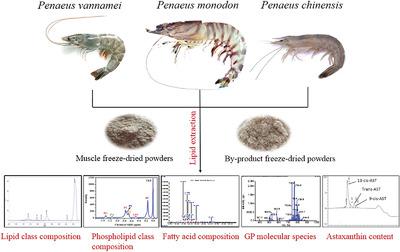当前位置:
X-MOL 学术
›
Eur. J. Lipid Sci. Technol.
›
论文详情
Our official English website, www.x-mol.net, welcomes your
feedback! (Note: you will need to create a separate account there.)
Lipid Profiles in By‐Products and Muscles of Three Shrimp Species (Penaeus monodon, Penaeus vannamei, and Penaeus chinensis)
European Journal of Lipid Science and Technology ( IF 1.8 ) Pub Date : 2020-05-25 , DOI: 10.1002/ejlt.201900309 Zhuo‐Liang Yu 1 , De‐Yang Li 1 , Fa‐Wen Yin 1, 2 , Qi Zhao 1, 2 , Zhong‐Yuan Liu 1 , Liang Song 1, 2 , Da‐Yong Zhou 1, 2 , Tong Wang 3
European Journal of Lipid Science and Technology ( IF 1.8 ) Pub Date : 2020-05-25 , DOI: 10.1002/ejlt.201900309 Zhuo‐Liang Yu 1 , De‐Yang Li 1 , Fa‐Wen Yin 1, 2 , Qi Zhao 1, 2 , Zhong‐Yuan Liu 1 , Liang Song 1, 2 , Da‐Yong Zhou 1, 2 , Tong Wang 3
Affiliation

|
To better understand the health benefits of lipids in shrimp and evaluate their potential value, a comprehensive analysis of lipid profiles in by‐products (head and body carapace) and muscles of shrimps Penaeus monodon, Penaeus vannamei, and Penaeus chinensis is performed. Results show that freeze‐dried muscles of these shrimps contain 3.83%, 4.39%, and 2.93% of lipids, respectively, while the corresponding by‐products contain 4.69%, 5.89%, and 5.39% of lipids, respectively. The total lipids comprise glycerophospholipid (PL, 54.86–77.29%), cholesterol (12.67–18.79%), triacylglycerol (1.28–7.02%), diacylglycerol (0.27–1.58%), monoacylglycerol (0.32–3.04%), and free fatty acid (FFA, 2.84–20.58%). Further, PL contains cholineglycerophospholipid (PLCho, 49.75–66.99 mol%), ethanolamineglycerophospholipid (PLEtn, 14.02–28.16 mol%), serineglycerophospholipid (PLSer, 4.85–12.66 mol%), inositolglycerophospholipid (PLIns, 4.36–15.63 mol%), and cholinelysoglycerophospholipid (LPLCho, 2.07–6.35 mol%). Lipids are abundant in polyunsaturated FA (36.55–42.72% of total FA), among which eicosapentaenoic acid (6.38–11.59% of total FA), and docosahexaenoic acid (7.63–12.08% of total FA) are dominant. About 200 species of PL belonging to PLCho, PLEtn, PLIns, LPLCho, lysoglycerophosphoethanolamine (LPLEtn), and lysoglycerophosphoserine (LPLSer) are characterized. Moreover, the by‐products contain higher amounts of astaxanthin than the muscles. Considering high level of PUFA enriched PL, shrimp by‐products can serve as a source for nutritional lipids.
中文翻译:

三种虾副产品和肌肉(对虾,对虾,南美白对虾和中华对虾)的脂质分布
为了更好地了解虾类脂质对健康的益处并评估其潜在价值,对虾对虾,斑节对虾,南美白对虾和中华对虾的副产品(头和甲壳)和肌肉中的脂质谱进行了综合分析被执行。结果表明,这些虾的冻干肌肉分别含有3.83%,4.39%和2.93%的脂质,而相应的副产品分别含有4.69%,5.89%和5.39%的脂质。总脂质包括甘油磷脂(PL,54.86–77.29%),胆固醇(12.67–18.79%),三酰基甘油(1.28–7.02%),二酰基甘油(0.27–1.58%),单酰基甘油(0.32-3.04%)和游离脂肪酸(FFA,2.84–20.58%)。此外,PL包含胆碱甘油磷脂(PLCho,49.75–66.99 mol%),乙醇胺甘油磷脂(PLEtn,14.02–28.16 mol%),丝氨酸甘油磷脂(PLSer,4.85–12.66 mol%),肌醇甘油磷脂磷脂(PLIns,4.36–15.63 mol%) (LPLCho,2.07–6.35 mol%)。多不饱和脂肪酸中脂质含量很高(占总脂肪酸的36.55–42.72%),其中二十碳五烯酸(6.38–11)。占总脂肪酸的59%)和二十二碳六烯酸(占总脂肪酸的7.3-12.08%)占主导。对属于PLCho,PLEtn,PLIns,LPLCho,溶血甘油磷酸乙醇胺(LPLEtn)和溶血甘油磷酸丝氨酸(LPLSer)的大约200种PL进行了表征。此外,副产品所含虾青素的含量高于肌肉。考虑到富含PUFA的PL含量很高,虾副产品可作为营养脂质的来源。
更新日期:2020-05-25
中文翻译:

三种虾副产品和肌肉(对虾,对虾,南美白对虾和中华对虾)的脂质分布
为了更好地了解虾类脂质对健康的益处并评估其潜在价值,对虾对虾,斑节对虾,南美白对虾和中华对虾的副产品(头和甲壳)和肌肉中的脂质谱进行了综合分析被执行。结果表明,这些虾的冻干肌肉分别含有3.83%,4.39%和2.93%的脂质,而相应的副产品分别含有4.69%,5.89%和5.39%的脂质。总脂质包括甘油磷脂(PL,54.86–77.29%),胆固醇(12.67–18.79%),三酰基甘油(1.28–7.02%),二酰基甘油(0.27–1.58%),单酰基甘油(0.32-3.04%)和游离脂肪酸(FFA,2.84–20.58%)。此外,PL包含胆碱甘油磷脂(PLCho,49.75–66.99 mol%),乙醇胺甘油磷脂(PLEtn,14.02–28.16 mol%),丝氨酸甘油磷脂(PLSer,4.85–12.66 mol%),肌醇甘油磷脂磷脂(PLIns,4.36–15.63 mol%) (LPLCho,2.07–6.35 mol%)。多不饱和脂肪酸中脂质含量很高(占总脂肪酸的36.55–42.72%),其中二十碳五烯酸(6.38–11)。占总脂肪酸的59%)和二十二碳六烯酸(占总脂肪酸的7.3-12.08%)占主导。对属于PLCho,PLEtn,PLIns,LPLCho,溶血甘油磷酸乙醇胺(LPLEtn)和溶血甘油磷酸丝氨酸(LPLSer)的大约200种PL进行了表征。此外,副产品所含虾青素的含量高于肌肉。考虑到富含PUFA的PL含量很高,虾副产品可作为营养脂质的来源。











































 京公网安备 11010802027423号
京公网安备 11010802027423号